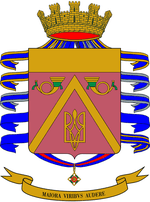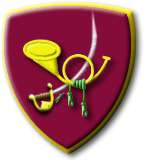Garibaldi Bersaglieri Brigade
| Brigata Bersaglieri "Garibaldi" | |
|---|---|
|
Coat of Arms Garibaldi Bersaglieri Brigade | |
| Active |
1 November 1975 - 1 July 1991 8th Mechanized Brigade Garibaldi 1 July 1991 - 1 September 1994 8th Bersaglieri Brigade Garibaldi 1 September 1994 - today Garibaldi Bersaglieri Brigade |
| Country | Italy |
| Allegiance | Italian Army |
| Branch | Army |
| Type | Brigade |
| Role | Bersaglieri |
| Part of | Acqui Division Command |
| Garrison/HQ | Caserta |
| Colors | dark red |
| Engagements |
Bosnia SFOR Kosovo KFOR Afghanistan ISAF Iraq Multinational force in Iraq Lebanon UNIFIL |
| Commanders | |
| Current commander | Brigadier Luigi Scollo |
The Garibaldi Bersaglieri Brigade is a mechanized infantry brigade of the Italian Army, based in the south of the country. Its core units are the Bersaglieri, the elite infantry corps of the Italian Army.
Formation
The brigade was activated during a major reorganization of the Italian Army: in 1975 the regiment level was abolished and battalions came under direct command of newly formed brigades, which combined units from different arms. On 1 November 1975 the Garibaldi Mechanized Brigade was activated one month after its sister brigades the Manin Armored Brigade and the Mameli Armored Brigade had been activated with the disbanded regiments of the Ariete Armored Division.
The brigade's headquarters was in the city of Pordenone. The brigade's name was chosen to honor the Italian patriot Giuseppe Garibaldi. The brigade's sister brigades in the Ariete Armored Division, the Manin Armored Brigade and Mameli Armored Brigade, were named in honor of Daniele Manin and Goffredo Mameli, both heroes of the Italian unification. The Ariete was part of the 5th Army Corps based in North-Eastern Italy. The 5th Army Corps was tasked with defending the Italian-Yugoslavian border against possible attacks by either the Warsaw Pact, or Yugoslavia or both. The Ariete Armored Division was based in the middle of the potential front. The brigade's authorized strength was 4,733 men (272 officers, 637 non-commissioned officers and 3,824 soldiers) consisted of the following units:
- Garibaldi Command and Signal Battalion, in Pordenone
-
 7th Tank Battalion M.O. Di Dio, in Vivaro, (M60A1 main battle tanks)
7th Tank Battalion M.O. Di Dio, in Vivaro, (M60A1 main battle tanks) -
 3rd Bersaglieri Battalion Cernaia, in Pordenone, (VCC-1 armored personnel carriers)
3rd Bersaglieri Battalion Cernaia, in Pordenone, (VCC-1 armored personnel carriers) -
 26th Bersaglieri Battalion Castelfidardo, in Maniago, (VCC-1 armored personnel carriers)
26th Bersaglieri Battalion Castelfidardo, in Maniago, (VCC-1 armored personnel carriers) -
 19th Self-propelled Field Artillery Group Rialto, in Sequals, (M109 self-propelled howitzers)
19th Self-propelled Field Artillery Group Rialto, in Sequals, (M109 self-propelled howitzers) -
 Garibaldi Logistic Battalion, in Pordenone
Garibaldi Logistic Battalion, in Pordenone - Garibaldi Anti-tank Company, in Vivaro
- Garibaldi Engineer Company, in Orcenico Superiore
On July 1, 1976 the brigade added the 11th Bersaglieri Battalion Caprera in Orcenico Superiore. With the abolition of the divisional level in the Italian Army on October 1, 1986 the Garibaldi came under direct control of the 5th Army Corps.
1990s
With the end of the Cold War and the following massive reorganization of the Italian Army the brigade was transferred to the South of Italy. The brigade finished the move south to the city of Caserta and declared full operational capability on 1 July 1991. Along with the move the brigade changed its name to 8th Bersaglieri Brigade Garibaldi to reflect the changed composition of its subordinated units:
- Garibaldi Command and Tactical Support Battalion, in Caserta
-
 31st Tank Battalion M.O. Andreani, in Persano
31st Tank Battalion M.O. Andreani, in Persano -
 19th Cavalry Squadron Cavalleggeri Guide, in Salerno
19th Cavalry Squadron Cavalleggeri Guide, in Salerno -
 3rd Bersaglieri Battalion Cernaia, in Caserta
3rd Bersaglieri Battalion Cernaia, in Caserta -
 67th Bersaglieri Battalion Fagarè, in Cosenza
67th Bersaglieri Battalion Fagarè, in Cosenza -
 91st Infantry (Training) Battalion Lucania, in Potenza
91st Infantry (Training) Battalion Lucania, in Potenza -
 11th Self-propelled Field Artillery Group Teramo, in Persano
11th Self-propelled Field Artillery Group Teramo, in Persano -
 Garibaldi Logistic Battalion, in Caserta
Garibaldi Logistic Battalion, in Caserta - Garibaldi Medical Battalion, in Caserta
Following the move the brigade became the first brigade in Italy to fully professionalize. From 1992 onwards all soldiers of the brigade were professional soldiers or long term volunteers. During the later 1990s the brigades composition changed slightly as a result of the massive reduction of forces after the Cold War and the Armys desire to preserve the names of the most decorated units of the Army. Therefore, most units changed names, although garrison and composition of the units did not change. The brigade itself shed the number from its name 1 on September 1994. The changes to the brigades units over the coming years follow below:
- 5 August 1991 the 19th Cavalry Squadron Cavalleggeri Guide changes its name to 19th Cavalry Regiment Cavalleggeri Guide
- 26 June 1993 the 3rd Bersaglieri Battalion Cernaia becomes the 8th Bersaglieri Regiment
- 1 September 1993 the 31st Armored Battalion M.O. Andreani becomes the 131st Tank Regiment
- 10 September 1993 the 67th Bersaglieri Battalion Fagarè becomes the 18th Bersaglieri Regiment
- 10 September 1992 the 11th Self-propelled Field Artillery Group Teramo changes its name to 11th Self-propelled Field Artillery Regiment Teramo
- in 1998 the 91st Infantry (Training) Battalion Lucania is transferred to the Training Brigade
- 1 December 2000 the 21st Engineer Regiment in Caserta joins the brigade
- 1 February 2001 the Garibaldi Logistic Battalion and Garibaldi Medical Battalion merge to form the 10th Logistic Maneuver Regiment, which is transferred to the Armys Logistic Brigade
- 1 October 2001 the 11th Self-propelled Field Artillery Regiment Teramo changes its name to 8th Self-propelled Artillery Regiment Pasubio
- 1 January 2005 the 18th Bersaglieri Regiment changes name and becomes the 1st Bersaglieri Regiment
Today
Today the Garibaldi Bersaglieri Brigade is one of two brigades of the Italian Army equipped with tracked vehicles. It has been employed in Karbala Iraq during the Iraq War and in Herat in Afghanistan as part of the International Security Assistance Force. Currently its structure is:
- Command and Tactical Support Battalion
-
 19th Cavalry Regiment Cavalleggeri Guide, in Salerno
19th Cavalry Regiment Cavalleggeri Guide, in Salerno -
 4th Tank Regiment, in Persano
4th Tank Regiment, in Persano -
 1st Bersaglieri Regiment, in Cosenza
1st Bersaglieri Regiment, in Cosenza -
 8th Bersaglieri Regiment, in Caserta
8th Bersaglieri Regiment, in Caserta -
 8th Self-propelled Artillery Regiment Pasubio, in Persano
8th Self-propelled Artillery Regiment Pasubio, in Persano -
 21st Engineer Regiment, in Caserta
21st Engineer Regiment, in Caserta -
 Garibaldi Logistic Regiment in Persano
Garibaldi Logistic Regiment in Persano
All regiments are battalion sized.
Equipment
The tank regiment is equipped with Ariete main battle tanks, the cavalry regiment with Centauro tank destroyers and Puma 4x4 wheeled armored personnel carriers. The Bersaglieri regiments field a mix of Dardo infantry fighting vehicles and Lince light multirole vehicles. The artillery regiment is equipped with PzH 2000 self-propelled howitzers.

